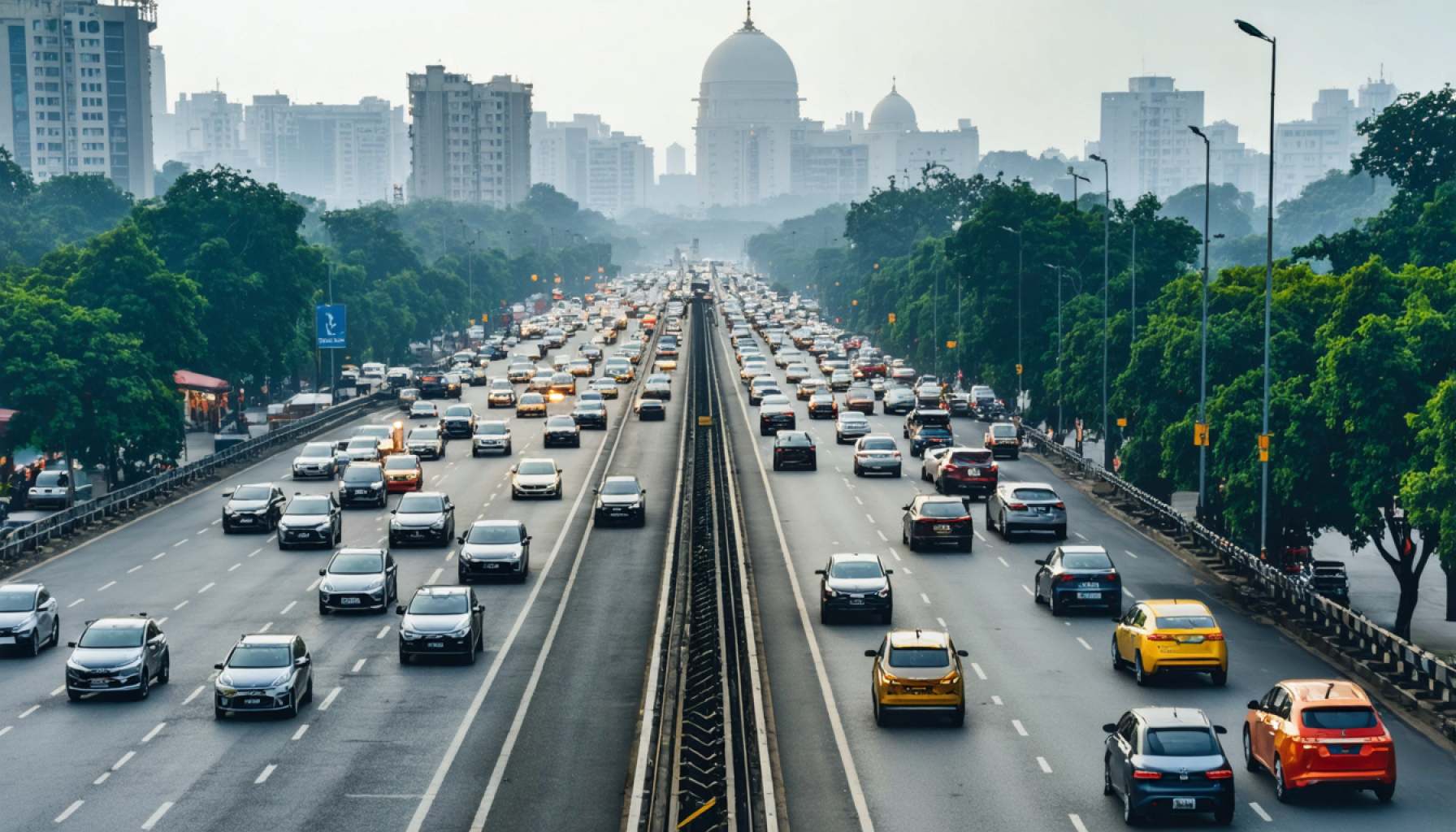
- Delhi’s Electric Vehicle (EV) Policy 2.0 aims to revolutionize urban transportation with the goal of 95% electrification of new vehicle registrations by 2027.
- The policy seeks to create approximately 20,000 jobs, boosting economic growth while transitioning to sustainable transport.
- The initiative focuses on establishing an extensive network of charging and swappable battery stations throughout the city.
- A comprehensive push targets the electrification of two-wheelers, buses, three-wheelers, and goods carriers, reducing reliance on fossil fuels.
- The Delhi Clean Mobility Center will manage policy administration, supported by a ‘State EV Fund’ from levies on non-electric vehicles.
- Skill Centers will train the workforce for new EV job markets, in partnership with academic institutions.
- Public awareness campaigns will promote the benefits of EVs, aligning citizen support with sustainable goals.
- Phase-out targets include ending petrol/diesel goods carriers by 2025 and retiring CNG autorickshaws by 2026.
As the sun casts its golden light on the bustling streets of Delhi, the city prepares for a transformative shift towards a greener future. The ambitious Electric Vehicle (EV) Policy 2.0 set forth by Delhi’s government is poised to turn the capital into a beacon of sustainable transportation, aimed at not just revolutionizing how people commute, but also nurturing economic growth through the creation of approximately 20,000 jobs.
At the heart of this dynamic policy lies an unwavering commitment to slashing emissions and battling pollution, one electric mile at a time. The streets of Delhi, often choked with the clamor of internal combustion engines, are set to echo the quiet hum of electric motors. The horizon is filled with the promise of cleaner air as the government aims to electrify 95% of all new vehicle registrations by 2027.
But this is just the beginning. The policy envisions a sprawling network of charging and swappable battery stations that will saturate the cityscape, ensuring that every electric vehicle has ample support for its journey. Picture a convenient, city-wide infrastructure where the thought of running low on battery becomes a relic of the past.
Further driving this green surge is a concerted effort to transition not only individual riders but also mass transport. Two-wheelers, buses, three-wheelers, and goods carriers are in line for a substantial shift to electricity, promising a cleaner commute for every sector of society. The policy’s sharp focus on eliminating fossil-fuel-driven public transport marks a definitive shift in the city’s ethos.
To support this transition, the envisioned Delhi Clean Mobility Center will take the reins of effective policy administration, supported by a robust ‘State EV Fund’. This financial backbone, drawing from existing levies on non-electric vehicles, ensures that the push towards electrification is not only visionary but also grounded in practical economics. The clean energy fund is set to become a critical artery, nourishing the pathways of this EV revolution.
In an equally crucial move, the policy outlines the establishment of Skill Centers, a forge where the city’s workforce will be molded into a formidable EV-skilled force. By collaborating with academic institutions, Delhi paves the way for an empowered generation ready to lead in the electrifying new job market.
Public awareness, often the Achilles heel of transformative policies, will be tackled with vigorous outreach programs. These initiatives aim to enlighten citizens about the manifold benefits of electric vehicles—not only as tools for personal mobility but as harbingers of a broader environmental benefit.
By the summer of 2025, petrol and diesel-powered goods carriers will join their CNG counterparts in the annals of history, as will CNG-driven autorickshaws by 2026. The capital boldly strides towards an era where dependency on fossil fuels is not just reduced but potentially eradicated in certain vehicle sectors.
As plans for the Electric Vehicle Policy 2.0 await approval from the Delhi Cabinet, the city stands on the cusp of a significant transformation. Should the policy receive the green light, brace yourself for a wave of change that washes away old habits and ushers in a new era of clean, efficient, and sustainable urban transportation.
The diesel flecks of yesterday’s smog-ridden horizon are giving way to the electric blue of tomorrow’s sky, inviting every Delhiite to ride the winds of change towards a future illuminated by innovation and sustainability. The stated ambition: by 2030, no corner of the city, no matter how remote, will lack the lifeline of electric recharging facilities, ensuring every journey is as seamless as the policy’s strategic intent.
Delhi’s Ambitious EV Policy 2.0: What You Need to Know and How It Will Impact You
Delhi is on the brink of a transformative shift towards sustainable transportation with its new Electric Vehicle (EV) Policy 2.0. This policy aims not only to modernize the city’s traffic landscape but also to contribute significantly to economic growth and environmental conservation. Here’s a deeper dive into the facts and potential implications of this policy.
Key Facts and Insights
1. Extensive EV Infrastructure Development
Delhi plans to build an expansive network of EV charging and swappable battery stations. This infrastructure will be crucial in assuring EV owners of the availability of charging services, reducing range anxiety—a common concern among potential EV buyers.
– Expected Coverage: By 2030, every corner of Delhi is anticipated to have access to recharging facilities. This will involve both fixed charging stations and innovative battery-swapping facilities.
2. Economic Growth and Job Creation
The policy is projected to create about 20,000 jobs. This growth will stem from various sectors including manufacturing, infrastructure development, maintenance, sales, and EV operation services.
– Skill Development: Establishment of skill centers will prepare the workforce for the demands of the EV industry, aligning with the city’s green vision.
3. Targeted Vehicle Segments
The policy aims to electrify key vehicle segments by specific deadlines to maximize impact on the city’s emission levels.
– Timeline Goals: Diesel and petrol goods carriers will be phased out by 2025, with CNG autorickshaws following by 2026.
4. Economic and Environmental Benefits
With a focus on reducing emissions, the policy aims to enhance air quality, thus mitigating health risks associated with pollution.
– Cleaner Air Initiative: Reducing pollution by transitioning to electric mobility will make the city more livable and align with global environmental goals.
How-To Steps for Adopting EVs in Delhi
1. Stay Informed: Keep track of the latest updates and incentives offered by the Delhi government for EV purchases.
2. Explore Subsidies: Check for available subsidies for purchasing EVs and installing home charging stations.
3. Plan Efficient Routes: Leverage the extensive charging network by planning routes that include convenient charging stops.
4. Engage in Training: Explore programs offered by skill centers to gain technical know-how for EV-related jobs.
5. Community Participation: Get involved in public awareness campaigns to understand the long-term benefits of EV adoption.
Real-World Use Cases
– Ride Sharing: Electric two-wheelers and three-wheelers can revolutionize urban ride-sharing by providing affordable and environmentally friendly options.
– Commercial Deliveries: EVs offer a cost-effective solution for last-mile delivery services, reducing operational costs and emissions.
Future Trends and Predictions
As other Indian states observe Delhi’s progress, similar policies may proliferate across the country, potentially positioning India as a global leader in electric mobility.
Challenges and Limitations
While the policy is ambitious:
– Infrastructure Buildout: Timely development of charging infrastructure remains crucial.
– Public Adoption: Overcoming skepticism and habitual reliance on combustion vehicles will require concerted efforts in public education.
Actionable Recommendations
– For Consumers: Assess the long-term cost benefits as incentives, reduced fuel costs, and lower maintenance can make EVs more affordable.
– For Businesses: Consider transitioning fleets to electric, which may provide operational savings and enhance corporate sustainability profiles.
Conclusion
Delhi’s EV Policy 2.0 is a beacon of change that could inspire similar transformations across urban landscapes worldwide. The quest for a cleaner, sustainable future starts with informed decisions and a collective effort towards embracing electric mobility.
For more information, visit the Delhi Government’s official website.



